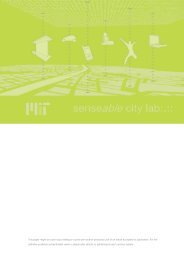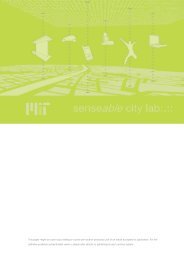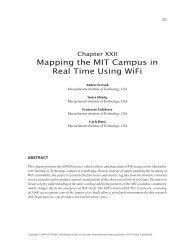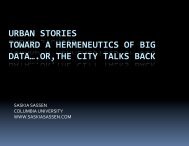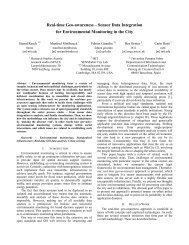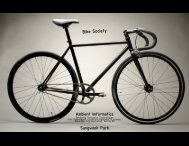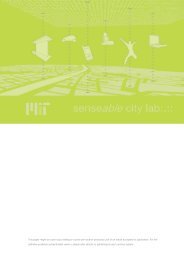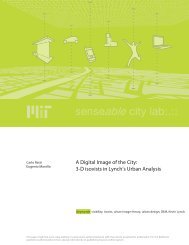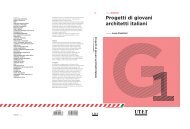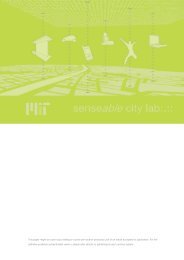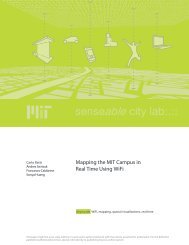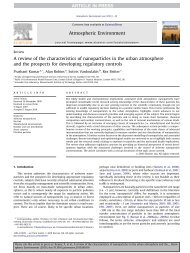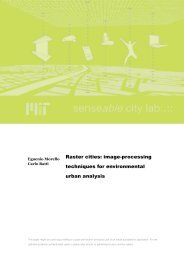Embedded Sensing for Standardised Urban Environmental Monitoring
Embedded Sensing for Standardised Urban Environmental Monitoring
Embedded Sensing for Standardised Urban Environmental Monitoring
Create successful ePaper yourself
Turn your PDF publications into a flip-book with our unique Google optimized e-Paper software.
The software infrastructure comprises an embeddedsecure web server (Nostromo nhttpd), an SQLite databaseand several daemons, which convert sensor readings be<strong>for</strong>ethey are served to the web. The database serves <strong>for</strong> shorttermstorage of historic measurements to allow <strong>for</strong> differenterror detection procedures and plausibility checks, as well as<strong>for</strong> non-sophisticated trend analysis.For standardised data retrieval, we have created a serviceimplementing the OGC Sensor Observation Service (SOS),SensorML and Observations and Measurements (O&M)standards in an application-specific way. Like this,measurement data are served via HTTP over UniversalMobile Telecommunications System (UMTS) in thestandardised XML-based O&M <strong>for</strong>mat over the SOS serviceinterface. SensorML serves <strong>for</strong> describing the whole sensorplat<strong>for</strong>m as well as to control the sensor via the OGC SensorPlanning Service (SPS), <strong>for</strong> instance to dynamically adjustmeasurement cycles.The overall service stack on the embedded sensingdevice is illustrated in Fig. 4.For the real-time data integration component, we havedeveloped a data store extension to the open-source productGeoServer 2 1.6. This plug-in enables the direct integration ofOGC SOS responses (in O&M <strong>for</strong>mat) into GeoServer andtheir conversion to OGC-con<strong>for</strong>mal service messages on-thefly.The main advantage of this approach is that sensor dataare made available through a variety of established geostandardisedinterfaces (OGC WFS, WMS, WCS), whichoffer a variety of output <strong>for</strong>mats such as OGC GeographicMarkup Language (GML), OGC Keyhole Markup Language(KML), geoRSS, geoJSON, Scalable Vector Graphics(SVG), JPEG or PDF.During the trans<strong>for</strong>mation procedure from O&M input toWFS output, certain input parameters (coordinate referencesystem, unit conversions, data structures etc.) are interpreted.In practice, this means that the O&M XML structure isconverted into well-established standardised data <strong>for</strong>mats asmentioned above.The innovation in comparison to previous dataintegration approaches is that the conversion of the datastructure from SOS responses to various WFS, WMS andWCS output <strong>for</strong>mats is per<strong>for</strong>med on-the-fly. Conventionalmethods typically use the laborious interim step of storingdata in a temporary database. This approach has two distinctdisadvantages. At first, it adds another component to theoverall workflow, which likely causes severe per<strong>for</strong>mancelosings; secondly, it creates a single central point of failuremaking the system vulnerable in case of technicalmalfunctions.On the contrary, our approach allows <strong>for</strong> theestablishment of a distributed sensor service architecture, andthus enables data provision of real-time measurements <strong>for</strong>heterogeneous application domains and requirement profiles.The direct conversion of data structures allows <strong>for</strong> the easyintegration of sensor data into GIS applications and there<strong>for</strong>eenables fast and ubiquitous data visualisation and analysis.In its current implementation, geographical analysis isper<strong>for</strong>med by ESRI’s ArcGIS software suite since reliableopen processing services are not yet available. We created aLive Sensor Extension that allows <strong>for</strong> the direct integration ofstandardised sensor data into ArcGIS. The Live Viewcomponent enables ad-hoc GIS processing and visualisationin a navigable map using ESRI’s Dynamic Displaytechnology. Fig. 5 shows an interpolated temperature surfacein ArcScene using the Inverse Distance Weighting (IDW)algorithm. In addition to ArcGIS, we have also used anumber of open/free clients such as Open Layers, uDig,Google Maps, Google Earth or Microsoft Virtual Earth tovisualise sensor in<strong>for</strong>mation in 2D and 3D.A second processing module implementing the LiveGeography framework is an ArcGIS Tracking Analyst basedspatio-temporal analysis component. For our study, we usedCO 2 data captured by the CitySense [8] network inCambridge, MA US.Figure 4. Software Infrastructure on the <strong>Embedded</strong> <strong>Sensing</strong> Device.2 http://www.geoserver.orgFigure 5. 3D Interpolation Using the Inverse Distance Weighting (IDW)Algorithm.




